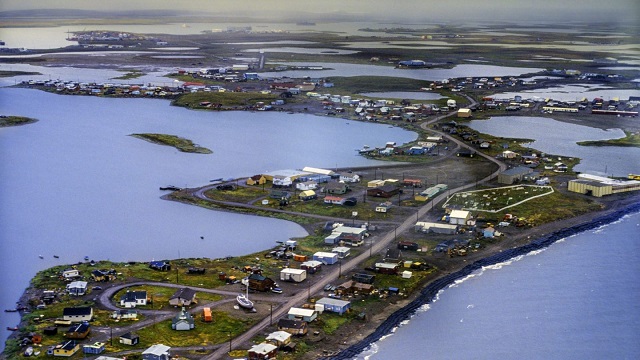Canadian Energy Centre
New compressed natural gas project to bring energy security to Canada’s north

Aerial view of the Hamlet of Tuktoyaktuk on the shores of the Beaufort Sea in the Canadian Arctic. Getty Images photo
From the Canadian Energy Centre
By Cody Ciona
‘The whole project is for the purpose of addressing the energy security issue that many northerners face’
The recent approval of the first compressed natural gas facility in the Northwest Territories is bringing energy security one step closer to remote and Indigenous communities in Canada’s north.
The Inuvialuit Energy Security Project (IESP), owned by the Inuvialuit Regional Corp. , will be located 16 kilometres south of Tuktoyaktuk. The project, recently approved by the Canadian Energy Regulator, will convert natural gas into compressed natural gas (CNG), propane, and diesel for the Inuvialuit Settlement region.
“The whole project is for the purpose of addressing the energy security issue that many northerners face, but particularly northerners that are at the end of a very long road,” said Inuvialuit Petroleum Corporation special advisor Kate Darling.
The natural gas will be supplied by the Tuk M-18 well, which is also owned by the Inuvialuit, and transported to local customers for power, heat, and fuel.
Currently, the region is serviced by the Inuvik Gas Project (natural gas from two wells at the Ikhil reservoir, 50 kilometres northwest of Inuvik), and by truck from the south in B.C. The Ikhil wells’ reserves are now critically low, which led to the push for the IESP. The Tuk M-18, however, is estimated to have more than 100 years’ worth of reserves.
About 200,000 people in Canada have no connection to an energy grid or natural gas distribution systems. This includes nearly 100,000 people in the northern territories.
In the Northwest Territories, refined petroleum products like diesel make up 74 per cent of end-use demand, brought in by trucks. In Inuvialuit’s case, that’s a 5,000-kilometre round trip including a ferry ride. In the past, Inuvialuit has faced potential operation disruption of the ferry service, which put the community in an emergency fuel situation.
“[The IESP] could provide long-term energy to the communities in the region, as well as reducing greenhouse gas emissions, creating long-term employment,” said Duane Ningaqsiq Smith, chair of the Inuvialuit Regional Corporation.
“It represents an Inuvialuit-led solution that takes into account the preservation of our values, advances participation in the northern and national economy, all while reducing emissions and helping preserve our local environment.”
In addition to providing energy security for remote communities, the IESP will have a significant positive impact on emissions reduction. It is estimated it will have a net reduction of around 40,000 tonnes of emissions per year, equivalent to the yearly emissions of 9,520 cars.
The project is also expected to support 25 full-time jobs and a further 35 full-time jobs within the local community.
“All in all … the M-18 will really help not just the surrounding communities of Tuk, but create a lot of jobs for locals, which is very good,” said Ryan Yakeleya, a Tuktoyaktuk councillor.
The IESP has already injected over $20 million into local businesses with over 70 Inuvialuit and Gwich’in peoples employed to date, according to the latest project update.
“IPC is committed to developing the IESP and ensuring that as much of the economic benefit and employment opportunities are offered to Inuvialuit,” said Duane Ningaqsiq Smith, IRC Chair and CEO.
The project is expected to begin producing and delivering gas to consumers by the end of 2025.
Alberta
Canada’s advantage as the world’s demand for plastic continues to grow

From the Canadian Energy Centre
By Will Gibson
‘The demand for plastics reflects how essential they are in our lives’
From the clothes on your back to the containers for household products to the pipes and insulation in your home, plastics are interwoven into the fabric of day-to-day life for most Canadians.
And that reliance is projected to grow both in Canada and around the world in the next three decades
The Global Plastics Outlook, published by the Paris-based Organization for Economic Co-operation and Development (OECD), forecasts the use of plastics globally will nearly triple by 2060, driven by economic and population growth.
The use of plastics is projected to double in OECD countries like Canada, the United States and European nations, but the largest increases will take place in Asia and Africa.
“The demand for plastics reflects how essential they are in our lives, whether it is packaging, textiles, building materials or medical equipment,” says Christa Seaman, vice-president, plastics with the Chemical Industry Association of Canada (CIAC), which represents Canada’s plastics producers.
She says as countries look to meet climate and sustainability goals, demand for plastic will grow.
“Plastics in the market today demonstrate their value to our society. Plastics are used to make critical components for solar panels and wind turbines. But they also can play a role in reducing weight in transportation or in ensuring goods that are transported have less weight in their packaging or in their products.”
Canada produces about $35 billion worth of plastic resin and plastic products per year, or over five per cent of Canadian manufacturing sales, according to a 2019 report published by the federal government.
Seaman says Canadian plastic producers have competitive advantages that position them to grow as demand rises at home and abroad. In Alberta, a key opportunity is the abundant supply of natural gas used to make plastic resin.
“As industry and consumer expectations shift for production to reduce emissions, Canada, and particularly Alberta, are extremely well placed to meet increased demand thanks to its supply of low-carbon feedstock. Going forward, production with less emissions is going to be important for companies,” Seaman says.
“You can see that with Dow Chemical’s decision to spend $8.8 billion on a net zero facility in Alberta.”
While modern life would not be possible without plastics, the CIAC says there needs to be better post-use management of plastic products including advanced recycling, or a so-called “circular economy” where plastics are seen as a resource or feedstock for new products, not a waste.
Some companies have already started making significant investments to generate recyclable plastics.
For example, Inter Pipeline Ltd.’s $4.3 billion Heartland Petrochemical Complex near Edmonton started operating in 2023. It produces a recyclable plastic called polypropylene from propane, with 65 per cent lower emissions than the global average thanks to the facility’s integrated design.
Achieving a circular economy – where 90 per cent of post-consumer plastic waste is diverted or recycled – would benefit Canada’s economy, according to the CIAC.
A Deloitte study, commissioned by Environment & Climate Change Canada, estimated diverting or reusing 90 per cent of post-consumer plastic waste by 2030 will save $500 million annually while creating 42,000 direct and indirect jobs. It would also cut Canada’s annual CO2 emissions by 1.8 megatonnes.
Right now, about 85 per cent of plastics end up in Canada’s landfills. To reach the 90 per cent diversion rate, Seaman says Canada must improve its infrastructure to collect and process the plastic waste currently being landfilled.
But she also says the industry rather than municipalities need to take responsibility for recycling plastic waste.
“This concept is referred to as extended producer responsibility. Municipalities have the responsibility for managing recycling within a waste management system. Given the competing costs and priorities, they don’t have the incentive to invest into recycling infrastructure when landfill space was the most cost-effective solution for them,” she says.
“Putting that responsibility on the producers who put the products on the market makes the most sense…The industry is adapting, and we hope government policy will recognize this opportunity for Canada to meet our climate goals while growing our economy.”
Business
Decarbonization deal opens new chapter in Alberta-Japan relationship

From the Canadian Energy Centre
By Will Gibson
Agreement represents a homecoming for JAPEX, which first started work in the Alberta oil sands in 1978
A new agreement that will see Japan Petroleum Exploration Company (JAPEX) invest in decarbonization opportunities in Alberta made history while also being rooted in the past, in the eyes of Gary Mar.
JAPEX is seeking to develop projects in carbon capture and storage (CCS), hydrogen and bioenergy. It’s part of the company’s JAPEX2050 strategy toward carbon neutrality.
“This new endeavour is a great opportunity that demonstrates the world is changing but the relationships endure,” says Mar, the province’s former trade envoy to Asia and the current CEO of the Canada West Foundation.
“Alberta’s very first international office was opened in Tokyo in 1981. And we have built a tremendous soft infrastructure that includes partnerships between a dozen Alberta and Japanese universities.”
For JAPEX, the agreement represents something of a homecoming for the company that first started work in the Alberta oil sands in 1978 and operated one of the first in situ (or drilled) oil projects for nearly two decades before selling its stake in 2018.
“We are now aiming to come back to Alberta and contribute to its decarbonization,” JAPEX president of overseas business Tomomi Yamada said in a statement.
Mar says the memorandum of understanding signed this March between JAPEX and the crown corporation Invest Alberta stems from a strong relationship built over decades.
“You can’t be considered a reliable partner for a new venture if you haven’t been a reliable partner for decades in the past,” says Mar.
“Economies change and world’s needs change but strong relationships are important factor in whom you do business with.”
Alberta’s established CCS infrastructure has already attracted new investment, including Air Products’ $1.6-billion net zero hydrogen complex and Dow Chemicals’ $8.8-billion net zero petrochemical complex.
Mar sees JAPEX’s deal with Invest Alberta opening a whole new market of potential carbon neutral investors in the Pacific Rim.
“When other countries who are partners in the Trans-Pacific Partnership (TPP) see JAPEX invest in this decarbonization opportunities and net zero projects in Alberta, it will send a very clear signal to others in the TPP about the potential,” Mar says.
“This deal may come from the decades-long relationship between Alberta and Japan but can also serve as a signpost for decades to come.”
-

 Censorship Industrial Complex2 days ago
Censorship Industrial Complex2 days agoDesperate Liberals move to stop MPs from calling Trudeau ‘corrupt’
-

 conflict2 days ago
conflict2 days agoCol. Douglas Macgregor torches Trump over support for bill funding wars in Ukraine and Israel
-

 Frontier Centre for Public Policy1 day ago
Frontier Centre for Public Policy1 day agoThe end of Canada: The shift from democracy to totalitarian behavior in the ‘pandemic era’
-

 Alberta21 hours ago
Alberta21 hours agoAlberta rejects unconstitutional cap on plastic production
-

 Energy1 day ago
Energy1 day agoReflections on Earth Day
-

 Great Reset2 days ago
Great Reset2 days agoTerrorists Welcome: Chronic counterterrorism lapses at the border demand investigation
-

 Business20 hours ago
Business20 hours agoUN plastics plans are unscientific and unrealistic
-

 conflict2 days ago
conflict2 days agoCol. Douglas Macgregor: US is ‘facing disaster’ as it funds overseas wars while bankrupt





